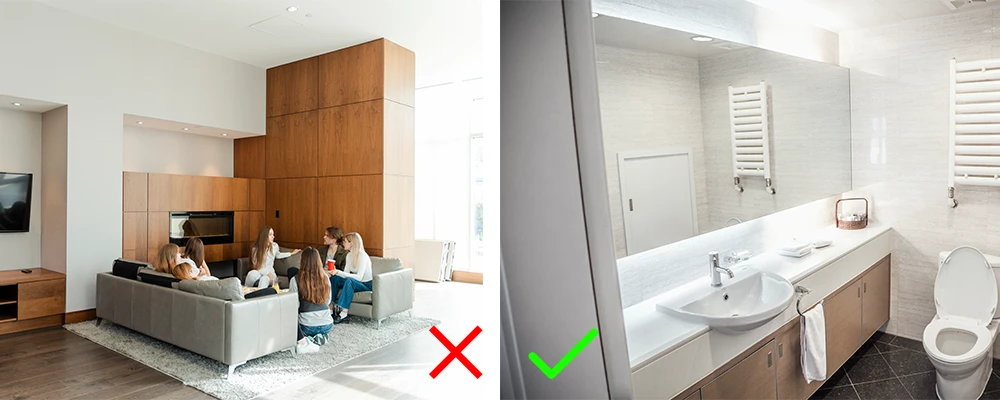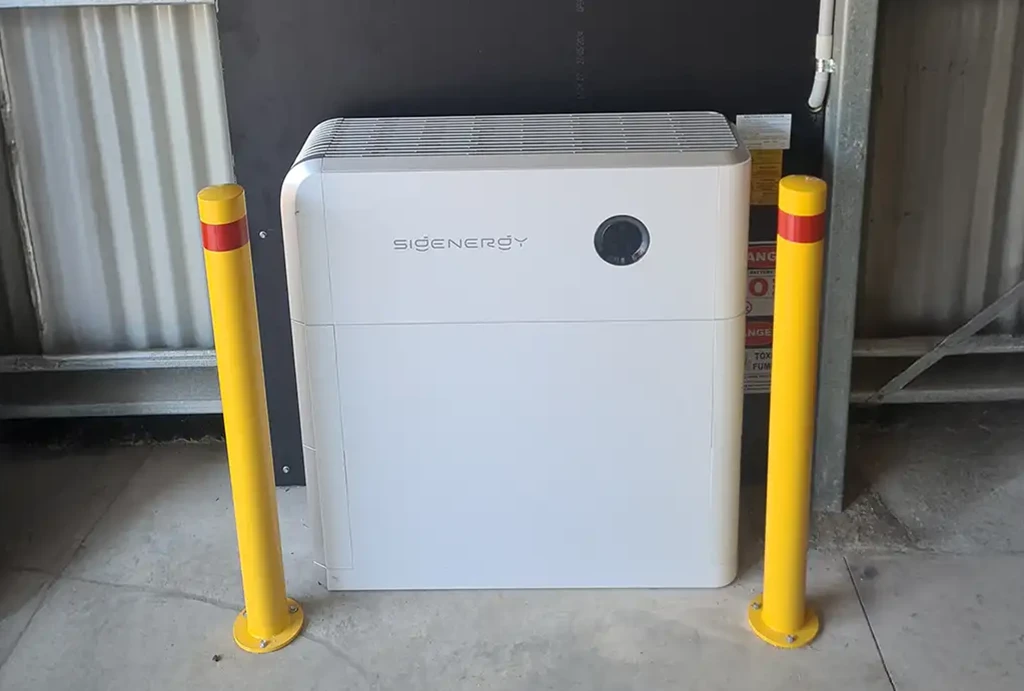
Solar batteries are now a standard part of home energy systems across New South Wales — from Sydney suburbs to regional towns. But before installing one, it’s important to understand the rules that apply across NSW. These govern everything from placement and safety barriers to clearances around gas fittings, exits and pathways.
At Better Volt, we follow all required Australian Standards, NSW electrical safety laws and network connection rules. These aren’t box-ticking exercises — they’re in place to keep your home safe and ensure your battery performs reliably through NSW’s mix of hot summer days, coastal humidity and colder inland winters.
Read This First
All battery installations in NSW must comply with:
- AS/NZS 5139:2019 – Electrical installations for battery systems
- AS/NZS 3000:2018 – Wiring Rules
- AS/NZS 4777.1 & 5033 – Inverter and PV-array requirements
Oversight and governance come from:
- NSW Fair Trading – electrical licensing and safety
- NSW Department of Energy – consumer safeguards
- Ausgrid, Endeavour Energy and Essential Energy – network service and installation rules
- Gas supplier standards – particularly for meter and relief-vent clearances
These rules outline where batteries can and cannot be located, the minimum distances you must maintain, and what to do when a battery backs onto a habitable room.
The goal is clear: avoid heat, ignition risks and blocked exits while keeping the battery protected from damage and weather.
Where a Battery Must Not Be Installed
AS/NZS 5139 and NSW Fair Trading align closely with other states, but some network providers add further requirements.
In NSW, batteries must NOT be installed in:
Hazardous areas
Including:
- Gas cylinder zones
- Gas meter clearance zones
- Areas with ignition hazards
- Zones defined as “hazardous” under AS/NZS 3000
Note: Ausgrid explicitly requires 1 m minimum clearance around gas relief vents unless the gas supplier specifies otherwise.
Escape routes
Such as:
- Hallways
- Walkways
- Fire-rated exit paths
- Under internal stairways
Battery systems cannot obstruct any part of an evacuation path.
Ceiling spaces or roof cavities
Unless the battery is placed inside a compliant, sealed, non-combustible enclosure.
Habitable rooms
Including:
- Bedrooms
- Living rooms
- Kitchens
- Dining areas
- Studies and playrooms
Batteries need to be in a garage, external wall, or purpose-built enclosure — not inside the living areas of a home.
Wet or exposed locations
Unless:
- The battery is outdoor-rated
- The installation follows manufacturer instructions
- Adequate shading and mounting are provided
Areas at risk of vehicles
Unless protected with compliant impact barriers or bollards.
What Counts as a Habitable Room in NSW?
NSW uses the National Construction Code (NCC) definitions:
A habitable room is any space used for daily living, such as bedrooms, lounge rooms, dining rooms, kitchens or studies.
Rule:
You cannot mount a battery directly on the wall of a habitable room unless a compliant fire barrier is installed.

Minimum Distances from Openings, Exits & Equipment
These distances come from AS/NZS 5139, NSW Fair Trading guidance and NSW network providers.
Openable windows & vents
- ≥ 600 mm horizontally
- ≥ 900 mm vertically below any opening into a habitable room
Doors & exits
- Keep 600 mm minimum clearance from any doorway up to 900 mm wide
- Allow at least 1 metre of clear access in front of the battery in pathways
Electrical equipment
- Keep 600 mm horizontal and 900 mm vertical clearance from devices such as:
- Air conditioners
- Heat pump units
- Hot water systems
- Pumps and pool equipment
Gas equipment
Clearances must meet:
AS/NZS 3000
- Jemena, Origin or gas supplier rules
- Network provider rules where applicable
Common guidance includes:
- 1,000 mm radius around gas relief vents
- 1,500 mm in direction of discharge
(Some NSW gas meter standards require even greater spacing in confined areas.)
Fire Barriers for Walls Backing Habitable Rooms
If a battery is mounted on — or within 300 mm of — a wall that backs onto a habitable room, NSW follows the AS/NZS 5139 requirement for a non-combustible fire barrier.
Acceptable materials include:
- Brick
- Concrete
- Masonry block
- Fibre cement sheeting
- Ceramic tiles
Barrier must:
- Extend 600 mm beyond each side of the battery
- Extend 900 mm above the battery
- Seal any penetrations larger than 5 mm
- Protect the ceiling if the battery’s top edge is within 900 mm
Access, Egress & Impact Protection
NSW Fair Trading and the network providers emphasise access and protection.
Access & servicing
Provide at least:
- 1 metre clear space in front of the battery
- Safe access for service and shutdown
When bollards are required
Bollards or a solid barrier are required when:
- A car could reverse into the battery
- The installation is inside a garage
- The driveway or turning arc reaches the unit
Typical compliant bollards:
- 70–100 mm diameter
- 900 mm height
- Fixed into the concrete slab

Manufacturer Clearances Still Apply
Product manuals may require extra spacing.
For example, a typical NSW-approved battery might require:
- Left/right: ≥ 100 mm
- Above: ≥ 50 mm
- Below: ≥ 20–50 mm
- Front/Service space: ≥ 300 mm
- Between multiple units: ≥ 100–150 mm
Your installer must follow whichever is stricter — the Australian Standard or the manufacturer.
Indoor vs Outdoor Installation in NSW
Outdoor or garage installation is preferred across NSW due to:
- Warmer summers
- High humidity in coastal regions
- Frost risk inland
Indoor installations are allowed only in non-habitable spaces and must meet all barrier and clearance rules.

Other Compliance Steps Better Volt Follows
For every solar battery installation, we:
- Test and verify all wiring under AS/NZS 3000
- Follow all battery wiring and protection rules under AS/NZS 5139
- Install and configure inverters per AS/NZS 4777.1
- Label all isolators and emergency shutdown devices
- Lodge all required documentation with Ausgrid, Endeavour or Essential Energy
- Provide full commissioning photos and compliance records
Local Note for Dorrigo and Surrounding Areas
Homes across Dorrigo, Bellingen Shire and the plateau region often come with their own set of installation considerations. Many properties have:
- External gas metres positioned close to living areas
- Narrow side access common in older cottages and rural homes
- Split-level or multi-storey layouts typical of properties built on sloping land
- Ageing switchboards that may require upgrades before adding a battery
- Larger loads such as heat pumps, EV chargers and high-use winter heating
Because many Dorrigo homes are exposed to cooler winter temperatures, misty conditions and higher rainfall, planning the battery location early helps avoid issues with weather exposure, clearances and future expansion. Checking gas metres, hot water units, drainage and walkway space beforehand ensures the installation goes smoothly without unexpected relocations later.
Why Choose Better Volt for Your Battery Installation
Better Volt delivers safe, compliant battery installations across New South Wales, following every requirement under AS/NZS 5139, AS/NZS 3000 and all NSW network service rules.
Our team measures all clearances, fits compliant fire barriers where required, and installs protection in garages or driveways. You’ll also receive full documentation, warranties and commissioning records.
If you’re ready to install a battery the correct way, talk to Better Volt today. From inspection to final sign-off, we handle every detail so you can enjoy reliable battery storage built for NSW homes and energy needs.
Geoff Tosio – Better Volt Solar + Batteries: Dorrigo